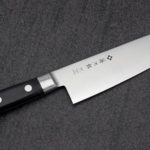Japanese knives are an essential tool for any kitchen, be it a home cook or a professional chef. The variety of Japanese knives available offer a precise and efficient way to prepare ingredients, elevating your culinary creations. Let’s explore the different types of Japanese knives and unlock their potential!
1 Chef’s Knife
 Chef’s Knife
Chef’s Knife
The chef’s knife is the ultimate workhorse in the kitchen. Its versatility allows you to cut and slice through a wide range of ingredients, from delicate vegetables to hearty meats. Designed with a lightweight construction, the blade typically measures between 15-35 cm in length and approximately 4 cm in width, ensuring comfortable and fatigue-free use even during extended cooking sessions. While its maneuverability and quick slicing capabilities are impressive, the long blade may take some practice to master.
2 Santoku Knife – The Multi-Purpose Wonder
 Santoku Knife
Santoku Knife
The Santoku knife is a true all-rounder in the kitchen. With its unique arched tip and wide blade, it effortlessly handles cutting, slicing, and dicing tasks, whether you’re working with meat, fish, or vegetables. This knife is an excellent choice for families, as its design prioritizes safety, making it ideal for households with children and elderly members.
3 Nakiri Knife – Vegetable Specialist
 Nakiri Knife
Nakiri Knife
The Nakiri knife is a vegetable enthusiast’s dream come true. While it excels at slicing vegetables, it can also handle fish and meat. However, it’s not designed for frozen foods or bones. Its distinctive downward-sloping tip and slightly curved shape make it a chopping powerhouse. The thin and long blade ensures precise cuts, making this knife a true specialist in the kitchen.
4 Petty Knife – Fruit Paring Made Easy
 Petty Knife
Petty Knife
The Petty knife is your go-to tool for fruit paring and peeling. Its compact and lightweight design features a sharp, pointed tip, making it perfect for removing seeds or rotten parts of fruits. However, it’s not meant for cutting frozen or hard foods, as they can chip or dull the blade.
5 Bread Knife – For Fluffy and Airy Slices
 Bread Knife
Bread Knife
As the name suggests, the bread knife is designed for one thing and does it exceptionally well—slicing bread and baked goods. Its long blade features a serrated edge that glides through the crust without compressing the soft interior, ensuring your bread stays fluffy and airy.
6 Deba Knife – Fish Filleting Expert
 Deba Knife
Deba Knife
The Deba knife is a specialized fish knife with a moderately long, thin, and sharp blade. Its dimensions typically range from 18-30 cm in length and up to 8 cm in width. The pointed tip makes cleaning and filleting fish a breeze. Additionally, the single-beveled design creates a smooth and aesthetically pleasing cut. This knife is ambidextrous, catering to both right- and left-handed users.
7 Sashimi Knife – Precision Slicing
 Sashimi Knife
Sashimi Knife
The Sashimi knife is designed for the ultimate precision. Its long, thin, and sharp blade, coupled with a pointed tip, enables you to create beautiful and delicious Sashimi dishes. Like the Deba knife, the Sashimi knife is also ambidextrous, accommodating both right- and left-handed chefs.
8 Chinese Cleaver – Versatile Chopper
 Chinese Cleaver
Chinese Cleaver
The Chinese Cleaver, also known as the Chinese Chef’s Knife, is a versatile tool originating from China. Its rectangular blade comes in varying thicknesses and weights, typically ranging from 300g to 900g. The lighter and thinner version is perfect for slicing, while the heavier and larger option excels at chopping chicken and mincing meat and vegetables.
9 Bone Chopper – Heavy-Duty Blade
 Bone Chopper
Bone Chopper
The Bone Chopper is a powerhouse in the kitchen, specifically designed for chopping bones. Its large, thick, and sharp blade, coupled with a sturdy handle, makes light work of tough bones. Weighing between 500-900g, this knife easily chops through pork leg bones, pig’s trotters, and even duck and chicken bones.
Now you know the different types of Japanese knives and their specific uses. Utilizing the right knife for the task at hand will not only enhance the presentation of your dishes but also make food preparation more efficient, and it will prolong the lifespan of your knives.
You may also like:


































